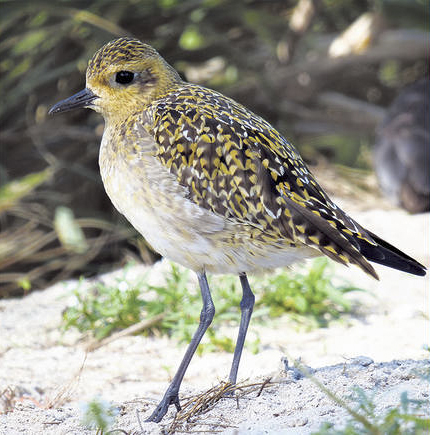Published in the Ocean Watch column, Honolulu Star-Advertiser © Susan Scott
August 5, 2017
Writing in all caps with multiple exclamation marks is the text equivalent of shouting. But those punctuation points and uppercase letters have their moments, and here’s one: OUR KOLEA ARE BACK!!!
 A Pacific golden plover, or kolea, pauses on Sand Island, Midway.
A Pacific golden plover, or kolea, pauses on Sand Island, Midway.
The atoll is about 1,000 miles from the main Hawaiian Islands,
to where the birds migrate from Alaska.
Courtesy Luke Halpin
The birds have been trickling in all week, returning from their child-rearing chores in Alaska.
On July 25, Pacific golden plover expert Wally Johnson forwarded me an email with the subject “Plover at BYUH.” Wally wrote, “They’re starting to head back — neat! The early ones in ‘fall’ are often females, as this one appears to be. They apparently leave the guys in charge of their growing kids and zip off to enjoy the less complicated life in Hawaii. So, the cycle is turning once again — amazing.”
The next day, Niu Valley resident Peter Ehrman emailed, “This evening I spotted a kolea in the back of the valley! Don’t know if it’s a very early arriver or a straggler that never left, but it’s definitely a kolea. Thought you’d like to know.”
I do want to know. It’s an exciting end-of-summer moment when we see a plover, and especially exciting when the individual that lives on our lawn or pecks on our street returns.
Just about everything regarding these birds is remarkable, but the one fact that drops all jaws is that each season’s chicks instinctively head south by themselves. They have no guidance besides the compass in their DNA.
Chicks stay in Alaska as long as the tundra still has bugs and berries. The youngsters need to build up enough body fat to make the 3,000-mile nonstop journey to the Hawaiian Islands.
Look for these skinny youngsters in October. If the snow falls late, some chicks arrive as late as November.
It’s a rough trip for a bird that just got its wings, and making it to Hawaii is no guarantee for survival. The young must compete for grazing space with older birds, many of which guard their foraging territory aggressively.
At best about 20 percent of summer chicks live through their first year. On a more cheerful note, the ones that make it through their first year have good potential for a long and healthy life.
When I told my husband about the two plover emails I received, he asked whether I was going to write about these early-bird arrivals.
Of course. Announcing the return to Oahu of our Pacific golden plovers is an honor I hold dear.
As another reader wrote about hearing and seeing a kolea on her neighbor’s rooftop July 26: “All is right with the world. The kolea are home.”
Thank you to all who wrote about the return of these marvelous migratory shorebirds. We may not be actually shouting, but we’re thinking it. WELCOME HOME, KOLEA!!